

Category:Image processing. Image processing is the application of signal processing techniques to the domain of images — two-dimensional signals such as photographs or video.
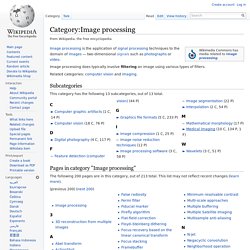
Image processing does typically involve filtering an image using various types of filters. Related categories: computer vision and imaging. Subcategories This category has the following 13 subcategories, out of 13 total. Pages in category "Image processing" Data (computing) In an alternate usage, binary files (which are not human-readable) are sometimes called "data" as distinguished from human-readable "text".[4] The total amount of digital data in 2007 was estimated to be 281 billion gigabytes (= 281 exabytes).[5][6] At its heart, a single datum is a value stored at a specific location.
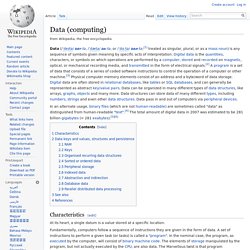
To store data bytes in a file, they have to be serialized in a "file format". Typically, programs are stored in special file types, different from those used for other data. Executable files contain programs; all other files are also data files. Technological singularity. The technological singularity is the hypothesis that accelerating progress in technologies will cause a runaway effect wherein artificial intelligence will exceed human intellectual capacity and control, thus radically changing civilization in an event called the singularity.[1] Because the capabilities of such an intelligence may be impossible for a human to comprehend, the technological singularity is an occurrence beyond which events may become unpredictable, unfavorable, or even unfathomable.[2] The first use of the term "singularity" in this context was by mathematician John von Neumann.
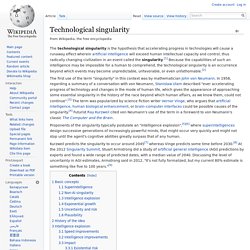
Proponents of the singularity typically postulate an "intelligence explosion",[5][6] where superintelligences design successive generations of increasingly powerful minds, that might occur very quickly and might not stop until the agent's cognitive abilities greatly surpass that of any human. Basic concepts Superintelligence Non-AI singularity Intelligence explosion Exponential growth. AirPort Time Capsule. Introduced on January 15, 2008 and released on February 29, 2008, the device has been upgraded several times, matching upgrades in the Extreme series routers.
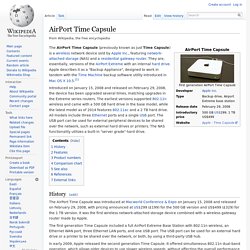
The earliest versions supported 802.11n wireless and came with a 500 GB hard drive in the base model, while the latest model as of 2014[update] features 802.11ac and a 2 TB hard drive. All models include three Ethernet ports and a single USB port. The USB port can be used for external peripheral devices to be shared over the network, such as external hard drives or printers. The NAS functionality utilizes a built-in "server grade" hard drive. §History[edit] The AirPort Time Capsule was introduced at Macworld Conference & Expo on January 15, 2008 and released on February 29, 2008, with pricing announced at US$299 (£199) for the 500 GB version and US$499 (£329) for the 1 TB version. In early 2009, Apple released the second generation Time Capsule. The third generation Time Capsule was released in October 2009. §Features[edit] Google. Google is an American multinational corporation specializing in Internet-related services and products.
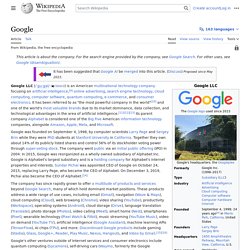
These include online advertising technologies, search, cloud computing, and software.[8] Most of its profits are derived from AdWords,[9][10] an online advertising service that places advertising near the list of search results. Google was founded by Larry Page and Sergey Brin while they were Ph.D. students at Stanford University. Together they own about 14 percent of its shares but control 56 percent of the stockholder voting power through supervoting stock. They incorporated Google as a privately held company on September 4, 1998. An initial public offering followed on August 19, 2004. History Google's original homepage had a simple design because the company founders were not experienced in HTML, the markup language used for designing web pages.[29] Tag (metadata) The use of keywords as part of an identification and classification system long predates computers.
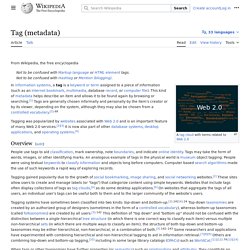
Paper data storage devices, notably edge-notched cards, that permitted classification and sorting by multiple criteria were already in use prior to the twentieth century, and faceted classification has been used by libraries since the 1930s. Online databases and early websites deployed keyword tags as a way for publishers to help users find content. In the early days of the World Wide Web, the keywords meta element was used by web designers to tell web search engines what the web page was about, but these keywords were only visible in a web page's source code and were not modifiable by users. "A Description of the Equator and Some ØtherLands", collaborative hypercinema portal, produced by documenta X, 1997.
High tech. High technology, often abbreviated to high tech (adjective forms high-technology, high-tech or hi-tech) is technology that is at the cutting edge: the most advanced technology available.
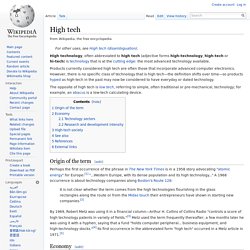
The opposite of high tech is low tech, referring to simple, often traditional or pre-mechanical, technology; for example, an abacus is a low-tech calculating device. §Origin of the term[edit] It is not clear whether the term comes from the high technologies flourishing in the glass rectangles along the route or from the Midas touch their entrepreneurs have shown in starting new companies.[2]